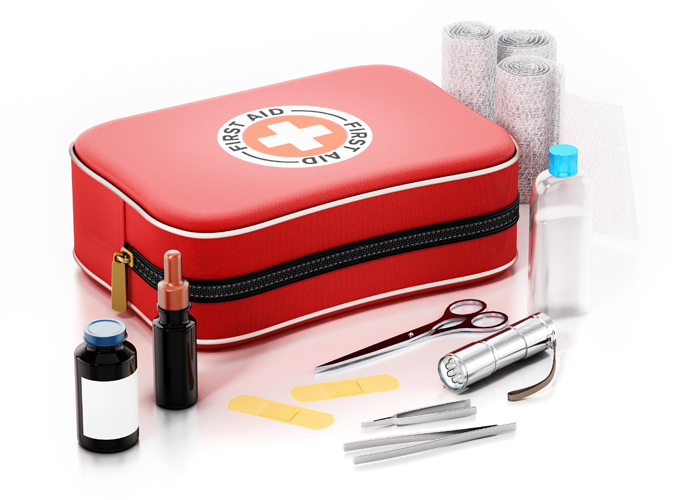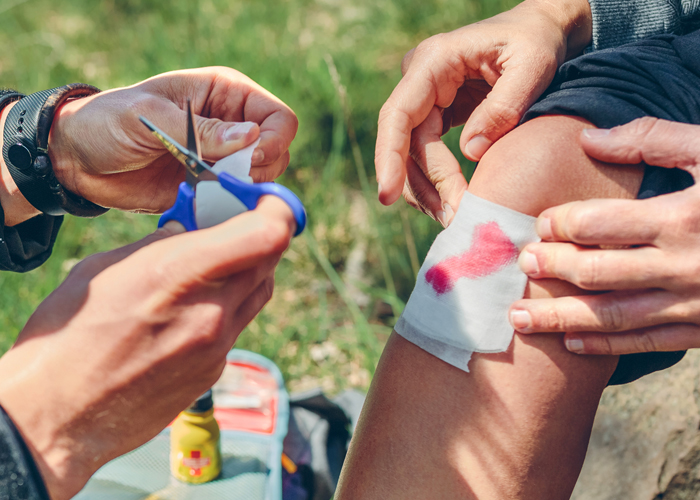First things first
In Common conditions
Follow this topic
Bookmark
Record learning outcomes
Examining the first aid market, discover changes in guidance and training, as well as trends towards more natural solutions

At the end of May, the St John Ambulance urged business and public sector leaders to include first aid training in their plans for returning to work. They had identified that more than 60,000 of the country’s workplace first aiders would have missed essential requalification courses during the Covid-19 lockdown.
St John offered free online refreshers during the initial furlough period, and reported that registrations on its online learning centre by workers in businesses and schools across the country increased 20-fold during a six week period in April-May.
The Health and Safety Executive (HSE) announced that if a First Aid at Work or Emergency First Aid at Work certificate expired on or after 16 March 2020, the validity of these certificates could be extended to 30 September 2020. “This extension applies as long as they are able to explain why they haven’t been able to requalify, and can demonstrate what steps they have taken to access the training,” says Mel Fox, director of training & enterprise at St John Ambulance. “This applies to England only. From July, we’ll be offering blended training courses, combining socially distanced and online training.”
For first aiders who haven’t had their skills refreshed or assessed in a while, it is essential that they do a requalification course as soon as they can, not least because guidelines on some skills have changed due to Covid-19. For instance, the Resuscitation Council has issued new guidance on CPR and resuscitation.
One way to increase pharmacy sales may be to concentrate on specialist or niche areas
Workplace requirements
According to The Health & Safety (First Aid) Regulations 1981, every workplace requires a first aid needs assessment to determine how many first aiders are required on the premises at any one time, as well as the first aid items that need to be kept in the workplace kit.
The person in charge of first aid arrangements needs to stock the first aid kit (including checking expiry dates) and call the emergency services when required. The regulations don’t require employers to provide first aid for members of the public. However, in the case of a high street pharmacy, this may need to be taken into consideration.
“Every workplace needs at least one first aid kit and someone to take responsibility for it, even in a low risk environment,” says Mel Fox. “With regard to qualified first aiders, it depends on a range of factors – not only how many employees, but, for example, the nature of the business and how remote the site is. Completing a first aid needs assessment will help businesses determine what they need to provide. St John provides a handy online calculator to help businesses work out how many first aiders and kits are needed.”
The contents of a workplace first aid kit are dependent on the first aid needs assessment in terms of what it contains and how big it needs to be. Last January, a new British Standard for workplace first aid kits, BS8599-1:2019, was published by the British Standard Institution (BSI). This details the components for small, medium, large, travel and personal issue first aid kits, as well as critical injury packs for workplace environments. As a minimum, the HSE says a workplace first aid kit in a low-risk environment might include:
- A leaflet giving general guidance on first aid
- Individually wrapped sterile plasters in assorted sizes
- Sterile eye pads
- Individually wrapped triangular bandages
- Safety pins
- Large and medium-sized sterile, individually wrapped unmedicated wound dressings
- Disposable gloves.
Nearby workplaces may need to replenish the contents of their first aid kits regularly, which can help to create a relationship with their local pharmacy. “Many businesses buy their kits online from major suppliers such as St John, but some local businesses may prefer to buy from a trusted local pharmacy,” says Mel Fox.
Character plasters boost child appeal
Character-themed children’s plasters remain as popular as ever among children and their parents. Numark’s Cathy Crossthwaite says that using these ranges can help parents treat minor cuts and grazes while taking their child’s mind off the pain with one of their favourite characters. “Leading brands within the category will often have a range of character products for customers to choose from, and these will need to be updated often to feature the latest characters in film and TV to stay relevant,” she says. “A range of character plasters within pharmacy can help drive impulse purchases and appeal to mums, who are a key pharmacy customer, shopping for the whole family.”
Elastoplast has been creating character-themed children’s plasters for decades, and now has more than 20 designs to choose from – including Disney Star Wars and Frozen. “Our history timeline shows that we talked about launching children’s plasters in 1974 for the first time,” says Rosie Lester, Elastoplast brand manager. “Back then, we had simple colours and some shapes, and since then our designs have come on to present some of the biggest characters in the world. Working with large partners like Nickelodeon and Disney means sales can also be connected to new movie releases. In general, we know that having characters or animals on our plasters helps children to forget their worries more easily. It helps them to get over the shock moment of injury and can be an additional distraction parents can offer when they treat a child’s wound.”
Category management
According to Cathy Crossthwaite, OTC business development manager at Numark, first aid is fairly prominent within pharmacy, holding around seven per cent of the GSL category. Dressings hold a higher share of space (61 per cent) due to the wide range of products available, such as plasters, dressings, bandages and tapes, and also because plasters are used more regularly by customers.
Many essential first aid supplies are available from other sources, such as websites or supermarkets, so one way to increase pharmacy sales may be to concentrate on specialist or niche areas, such as specialist dressings for specific wounds. Pharmacies can also highlight that they offer the opportunity to ask a trained healthcare professional for first aid advice. “A range of specialist bandages, tapes and dressings helps to take the category a step further in pharmacy,” says Cathy Crossthwaite. “Pharmacy has the advantage of being able to offer customers advice about a variety of first aid topics. Advice such as this is less likely to be available from other retailers.”
If there is a trained first aider on the premises, pharmacies could also stock products for immediate use, and show customers how to care for their injuries using the products and treatments sold in-store. “With a private consultation room and appropriate training/equipment, pharmacy has the ability to support customers with minor first aid injuries without the need for them to make an appointment with their GP or visit their local health centre,” says Ms Crossthwaite. “An appropriate product range supporting this can boost sales for pharmacy, such as topical pain for strains and sprains, as well as bandages, tapes and dressings that are more specific for certain wounds.”
Keeping up with advances and trends in first aid is important, so that pharmacies can offer the latest products. Many recent developments in the category have concentrated on ease of use, such as spray plasters, comfortable dressings and convenient, easy-to-apply antiseptics. Natural products are also a growing trend.
“It is vital for independent high street pharmacies to diversify their first aid offering to ensure they are catering to evolving customer demand,” says James Dutton, CEO and founder of Patch plasters for sensitive skin. “We recently conducted an in-person study, randomly walking into various high street pharmacies and asking for wound care that wouldn’t aggravate latex allergy or simply worked on sensitive skin and didn’t cause redness or a reaction. The response was staggering, as there were minimal (if any) options, and we left empty handed. Research shows that 25 per cent of consumers do react – and this is a large portion of the market that has been left unattended, until now. High street pharmacies have a significant opportunity to grow their sales by providing a solution for this largely untapped customer base.”
According to the brand manager for Traumeel, a natural pain relief product for musculoskeletal injuries such as sprains and strains, pharmacies could concentrate on stocking pharmacy-only products that won’t be sold in other outlets. “It is worth noting that Traumeel can only be dispensed by a pharmacist and offers a healthy return on even small quantity orders,” says the brand manager. “Stocking a wide variety of treatment options will be really important in meeting future customer needs. There are opportunities to offer a wider choice of natural remedies that can be effective in building relationships, encouraging repeat and cross-category purchases.”

Views from the P3pharmacy category panel
Sarina Mughal, Day Lewis, Knightsbridge
“This is an important category for our pharmacy. We keep a good stock of first aid kits and their contents. Many customers will just ask us for a first aid kit. If they need plasters, they tend to ask for specific types such as for children, hypoallergenic plasters or those with silver to aid healing. Best sellers are Elastoplast and a new organic brand, Patch – these include aloe vera, charcoal and bamboo. My top tip would be to display products in two areas of your pharmacy – with personal care, but also at the till point as it’s often something customers forget about until the last minute, so this can increase your sales.”
Lila Thakerar, Shaftesbury pharmacy, Harrow
“This has been a vital category for us during the pandemic, with people either not able to see their GP or reluctant to go to A&E for minor injuries. Often, we find that after a phone appointment with their GP, they get referred to the local pharmacy for treatment. We get asked about everything from cuts, burns and rashes to falls or allergic reactions. Anthisan cream and antihistamine eye drops sell well, as do burn gels and burn plasters, Savlon and Elastoplast. We have our first aid category in a prominent part of the pharmacy with a large display. It’s important to consider impulse purchases when siting your category.”
Yasmeen Asfar, Well pharmacy, Hartlepool
“This is an extremely important category. A huge portion of our customers seek advice for minor injuries. Our best selling products are Germolene, Savlon and plasters of various types. We also sell dressings, with mepore dressings being the most requested. For sprains and muscular injuries, heat rubs and ibuprofen gel are top sellers. A recent change I have encountered is the increase in sales of first aid kits. This category has huge potential for growth, as long as great ranges are available at affordable prices. It’s important to stock generics and to have displays that are clear and provide basic product knowledge.”

